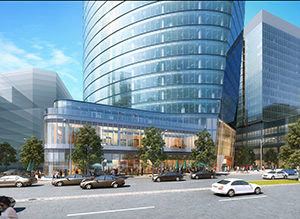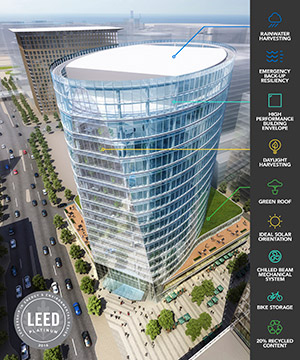







BOSTON — The new energy-efficient, 121 Seaport office tower, located in Boston’s Innovation District, is currently under construction and was topped out on March 10. While most commercial buildings reduce energy strictly through the use of lighting and other renewable energy features, this building’s elliptical shape enables passively reduced material and energy use.

A new energy-efficient office tower named 121 Seaport in Boston’s Innovation District is currently under construction, and was recently topped out on March 10.
Boston-based CBT Architects designed the elliptical building, with local offices of Skanska USA serving as the commercial development company and environmental consultant on the project. “One distinction between Skanska and others developers is its focus on sustainability and its environmental consciousness. This was an important element in having them on the project, and it was a pleasure working with them,” said David Nagahiro, principal architect at CBT.
The 17-story office tower will be 440,000 square feet, and its anticipated completion is spring of 2018, according to Phil Casey, principal architect at CBT. The firm will be pursuing LEED Platinum status for design and construction of the building, and is hoping for certification to go through sometime in 2018. Additional features that will earn this building LEED Platinum status are the use of a chilled-beam system, a green roof on top of the podium of the third floor, rainwater harvesting and the collection of roof water into a 40,000-gallon cistern, an overall water-reuse reclamation strategy and low-flow plumbing fixtures, according to Casey.
Contrasting the rectangular shape of traditional office towers, 121 Seaport’s elliptical structure enables a 10 percent reduction in building envelope linear footage, cutting down on construction costs and waste. Additionally, the building’s aerodynamic shape cuts down on surface area exposure to sun, producing energy savings of 15 percent and, as a result, reducing necessary cooling and heating costs, according to Casey. “In using this elliptical shape, we also decreased the amount of glass and other materials needed to build, so there was a materials reduction element to the sustainability of this design,” said Casey. Similarly, the building’s orientation towards wind lessens overall strain on the underlying infrastructure, thus reducing the need for excess steel structural support, according to Casey.

The building will be pursuing LEED Platinum status for design and construction, with certification projected for sometime in 2018.
Photo Credit (all): CBT
Another benefit of 121 Seaport’s curved shape is that it reduces structural impact by allowing more of the city’s skyline to be visible, as opposed to the traditional rectangular building shape and lines that can block incoming light. This creates a warm and welcoming feel for the space overall and to building tenants and visitors. More sky is visible, with less shadow on the surrounding public spaces. “From an environmental microclimate standpoint, due to the shallow form of the building shape, we were able to reduce the number of shadows as compared to the typical and nearby rectilinear buildings,” said Nagahiro.
As a result, the design team was able to increase “sky brightness” to see more sky from nearby neighborhood spaces rather than building facade. “Additionally, the building’s lobby is positioned in the direction of Seaport Square, [the neighborhood’s central green space], and we were able to achieve significant shadow reduction there through the use of our elliptical building design,” said Nagahiro.
One challenge that the design team faced was that the building itself is located directly over an underground transit line that drastically limited development options. This initial challenge turned out to be a great strength in the end, according to Nagahiro, as ever-evolving sustainable design solutions were elicited as a result. “The shape really took form out of necessity. And as a result, we feel we are representing innovation in the Innovation District. Not only is the building unique in form, but it is iconic on the skyline,” said Nagahiro.
Copyright 2006-2025 Shanghai Sinoexpo Informa Markets International Exhibition Co., Ltd. All rights reserved